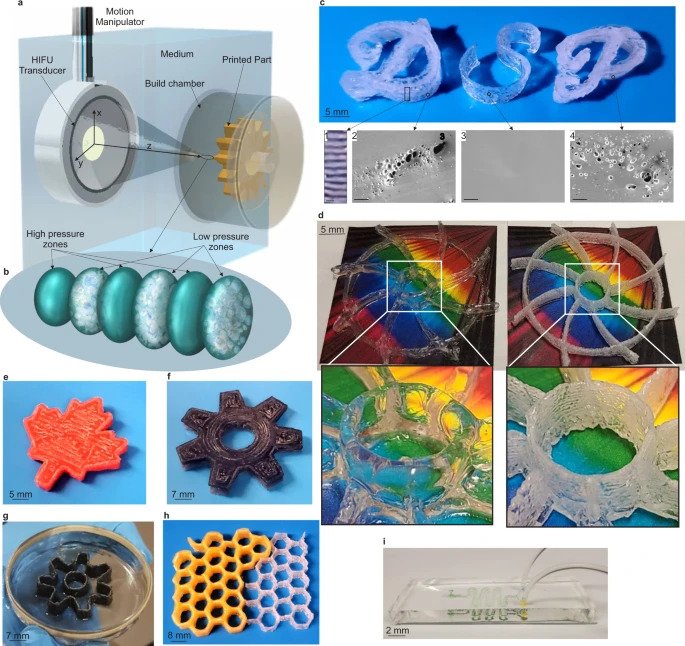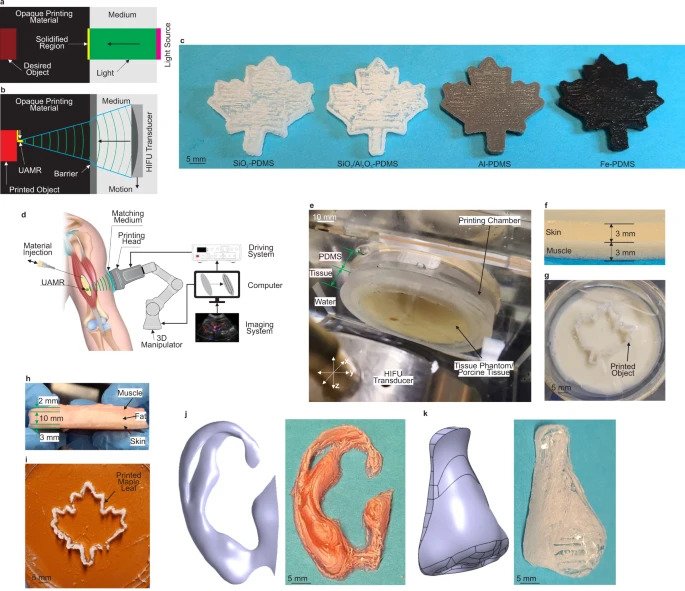Researchers from Concordia University have developed a novel direct sound printing (DSP) technique that leverages ultrasound waves to fabricate complex and precise objects.
The team has published a paper describing the technology, which works by using sound waves to create sonochemical reactions in minuscule cavities to produce pre-designed complex geometries that cannot be achieved with existing techniques.
“Ultrasonic frequencies are already being used in destructive procedures like laser ablation of tissues and tumors,” said Muthukumaran Packirisamy, a Professor in Concordia’s Department of Mechanical, Industrial and Aerospace Engineering. “We wanted to use them to create something.”
Ultrasonic 3D printing
The use of ultrasound in microparticle manipulation is not a new concept, with ultrasonic waves having proven to be a useful tool across multiple areas of 3D printing in the past.
The last few years have seen researchers from the University of Bath and the University of Bristol develop their Sonolithography bioprinting technique that uses ultrasound waves to precisely deposit particles into predetermined patterns, and biotechnology firm mimiX Biotherapeutics launch its own cymatiX acoustic bioprinter that leverages ultrasonic waves to pattern and condense living cells via resonance.
Ultrasound is also used for post-processing applications by the likes of post-printing system manufacturer PostProcess Technologies, which launched its Variable Acoustic Displacement (VAD) technology in 2020. VAD uses acoustic energy to non-destructively remove loose powder from 3D printed polymer parts.

DSP 3D printing
The Concordia team’s DSP technology relies on chemical reactions caused by fluctuating pressure inside tiny bubbles suspended in a liquid polymer solution. To create these reactions, the researchers leveraged oscillating focused ultrasound waves to transform polydimethylsiloxane (PDMS) liquid resin into solid or semi-solid forms.
The team used a transducer to generate an ultrasonic field that passes through the material’s shell and solidifies the targeted liquid resin before depositing it onto a platform or other previously solidified object.
The ultrasound waves cause extremely intense and short reactions within the micro-sized bubbles in the liquid, causing the temperature inside the cavities to shoot up to around 15,000 kelvin and the pressure to exceed 1,000 bar. Considering the Earth’s surface pressure at sea level is around one bar gives an indication as to the extreme pressure within the bubbles. As a result, the reaction time is so brief it only lasts a matter of picoseconds, one of which makes up just one trillionth of a second, and does not affect the surrounding material.
To create a desired shape, the transducer moves along a predetermined path solidifying the liquid pixel by pixel. The object’s microstructure can be controlled by adjusting the duration of the ultrasound wave’s frequency and the viscosity of the material being used.
Describing their method as a “game-changer” for the 3D printing industry, the team was able to generate objects with pre-designed complex geometries impossible to achieve with existing techniques.
“We found that if we use a certain type of ultrasound with a certain frequency and power, we can create very local, very focused chemically reactive regions,” said Mohsen Habibi, a Research Associate at Concordia’s Optical-Bio Microsystems Lab. “Basically, the bubbles can be used as reactors to drive chemical reactions to transform liquid resin into solids or semi-solids.”

Versatile and specific applications
According to the Concordia team, the versatility of their DSP technology will be of benefit to industries that rely on highly specific and delicate equipment. For instance, PDMS is already widely used within the microfluidics sector where manufacturers require controlled environments and sophisticated techniques to fabricate medical devices and biosensors.
Within the wider medical sector, the technology could potentially hold medical applications regarding remote in-body 3D printing within humans and animals, the team suggested.
DSP is also suited to engineering and repair applications within the aerospace sector, as the ultrasound waves the technology relies on are able to penetrate opaque surfaces like metallic shells. As such, the technology could enable maintenance crews to service parts located deep within an aircraft’s fuselage that would otherwise be inaccessible to other 3D printing techniques reliant on photoactivated reactions.
“We proved that we can print multiple materials, including polymers and ceramics,” added Packirisamy. “We are going to try polymer-metal composites next, and eventually we want to get to printing metal using this method.”
Further information on the study can be found in the paper titled: “Direct sound printing,” published in the Nature Communications journal. The study is co-authored by M. Habibi, S. Foroughi, V. Karamzadeh, and M. Packirisamy.

Subscribe to the 3D Printing Industry newsletter for the latest news in additive manufacturing. You can also stay connected by following us on Twitter and liking us on Facebook.
Looking for a career in additive manufacturing? Visit 3D Printing Jobs for a selection of roles in the industry.
Subscribe to our YouTube channel for the latest 3D printing video shorts, reviews, and webinar replays.
Featured image shows the concept of Concordia University’s DSP technology. Image via Nature Communications.


